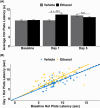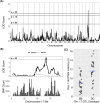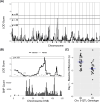Identification of ethanol analgesia quantitative trait loci and candidate genes in BXD recombinant inbred mouse lines
- PMID: 39996569
- PMCID: PMC11851315
- DOI: 10.1111/adb.70013
Identification of ethanol analgesia quantitative trait loci and candidate genes in BXD recombinant inbred mouse lines
Abstract
Alcohol consumption produces acute analgesic effects, and people experiencing pain conditions may drink alcohol to alleviate discomfort. However, tolerance to the analgesic properties of alcohol could prompt escalating consumption and dependence. Both nociception and alcohol-induced analgesia are under significant genetic control. Understanding the genetic architecture of these processes could inform better treatment options for people with pain conditions. This study aims to identify quantitative trait loci (QTL) driving variation in ethanol-induced analgesia across BXD recombinant inbred mouse lines. Male and female mice from 62 BXD strains received ethanol or saline oral gavage for five days and were tested for hot plate (HP) latency at baseline, Day 1 and Day 5. QTL mapping of HP phenotypes identified a significant provisional QTL on chromosome 17 for Day 1 HP latency in mice receiving ethanol. An additional highly suggestive QTL was present on chromosome 9 for the difference in pre- and post-ethanol thermal nociception. Candidate genes within QTL support intervals were provisionally identified using HP phenotypic correlations to transcriptomic database, expression QTL analysis and other bioinformatics inquiries. The combined behavioural and bioinformatic analyses yielded strong ethanol analgesia candidate genes, specifically Myo6. Thus, the results of this genetic study of ethanol-induced analgesia in BXD mouse strains may contribute significantly to our understanding of the molecular basis for individual variation in the analgesic response to acute ethanol.
Keywords: BXD; analgesia; ethanol; genetics.
© 2025 The Author(s). Addiction Biology published by John Wiley & Sons Ltd on behalf of Society for the Study of Addiction.
Conflict of interest statement
None declared.
Figures




Update of
-
Identification of ethanol analgesia quantitative trait loci and candidate genes in BXD recombinant inbred mouse lines.bioRxiv [Preprint]. 2024 Jun 17:2024.06.17.599372. doi: 10.1101/2024.06.17.599372. bioRxiv. 2024. Update in: Addict Biol. 2025 Feb;30(2):e70013. doi: 10.1111/adb.70013. PMID: 38948869 Free PMC article. Updated. Preprint.
References
-
- Centers for Disease Control and Prevention . 2024. Alcohol Related Disease Impact (ARDI) Application website . Cited March 23, 2024. http://www.cdc.gov/ARDI
MeSH terms
Substances
Grants and funding
LinkOut - more resources
Full Text Sources
Research Materials
Miscellaneous

